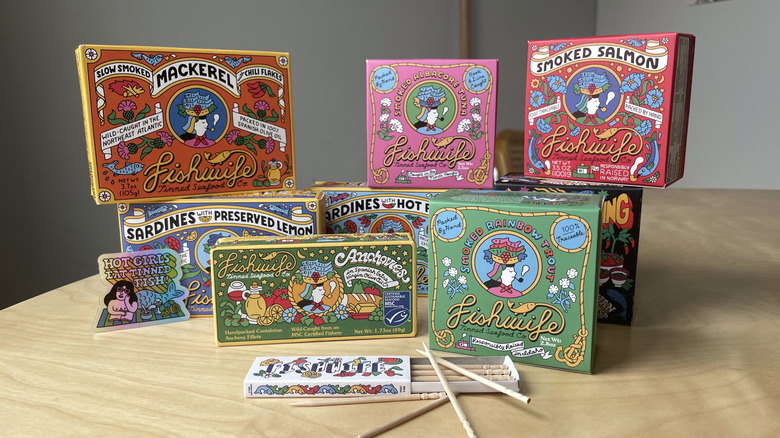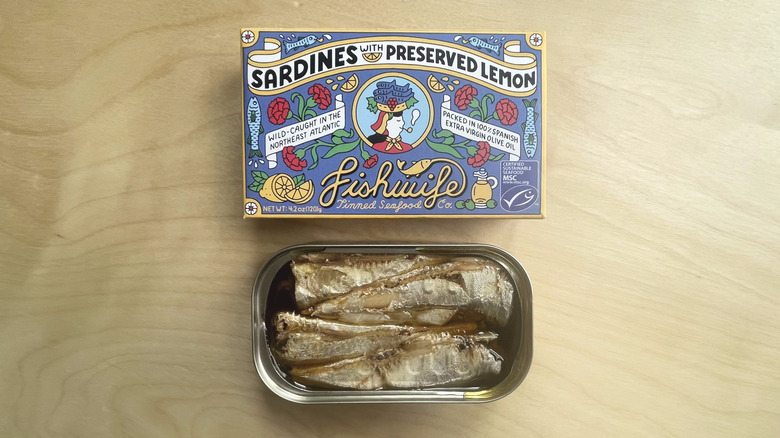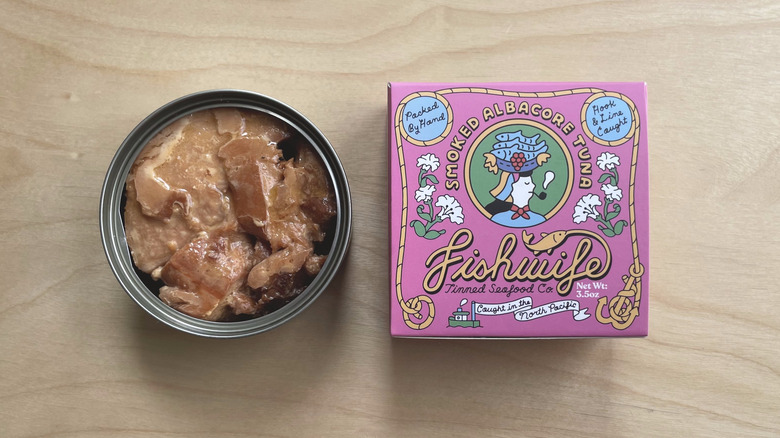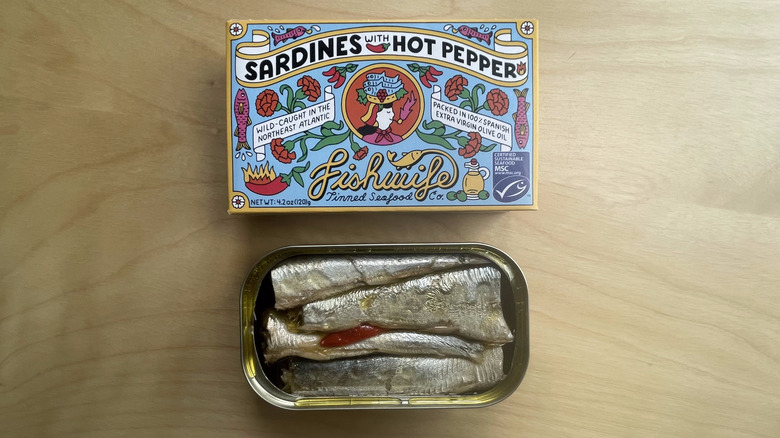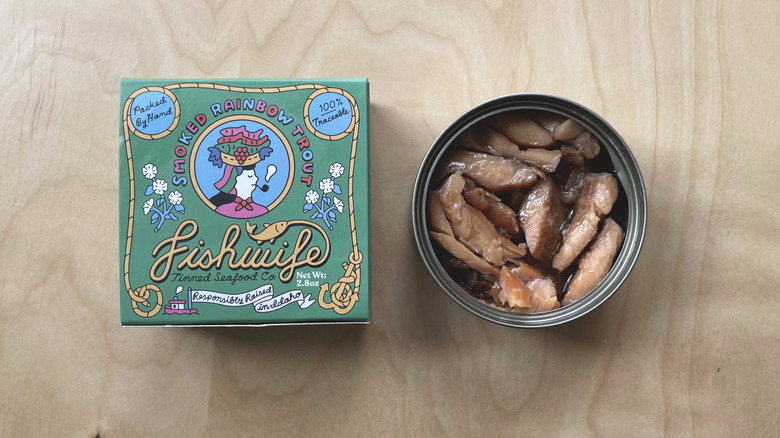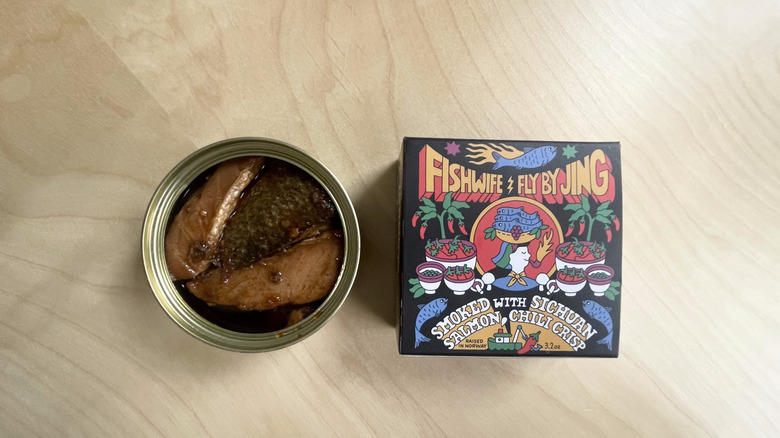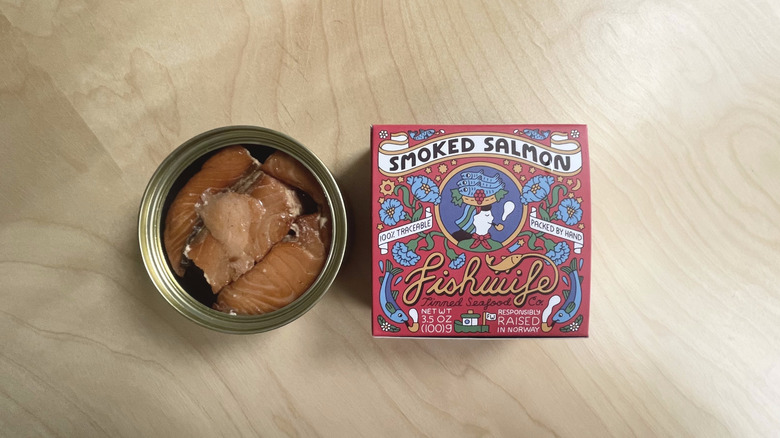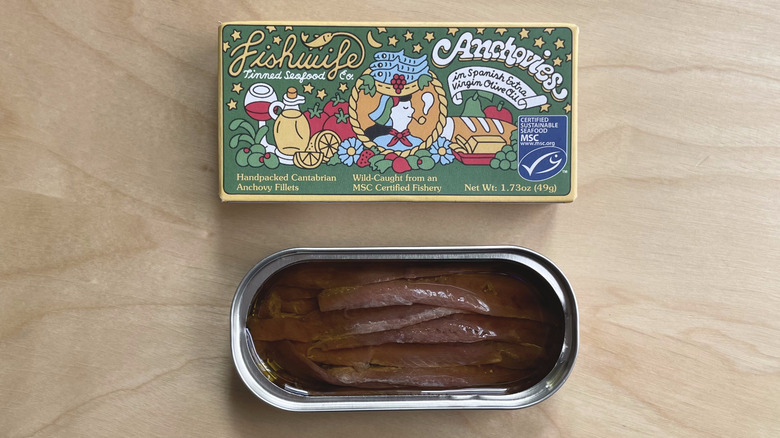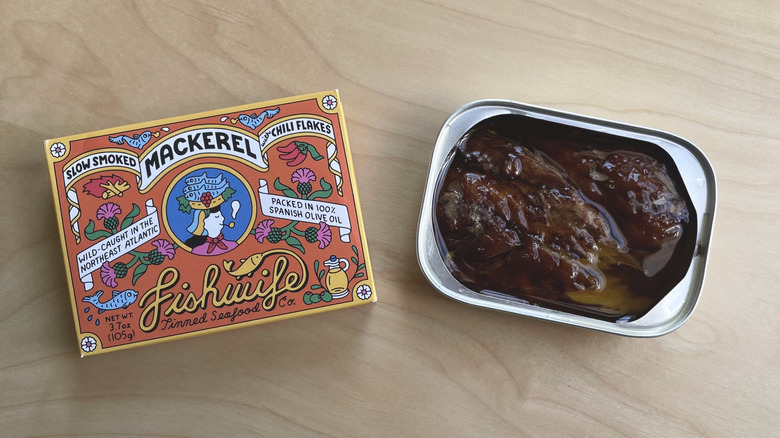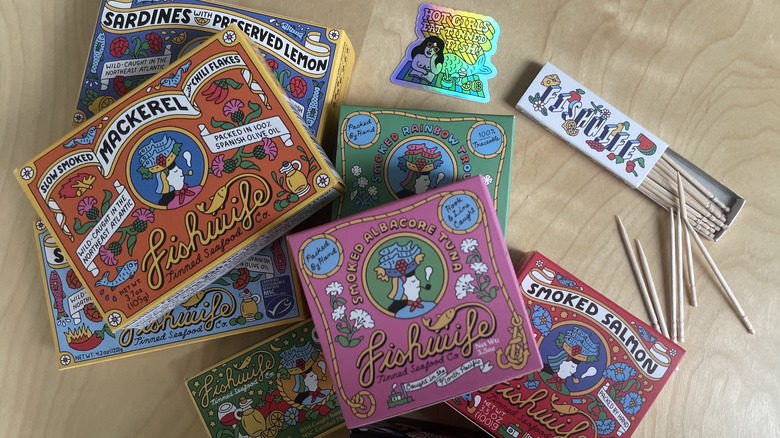We Tried And Ranked Every Fishwife Tinned Seafood Flavor
For the longest time, canned seafood in the U.S. was either homely or imported. The gap between convenient and cute loomed large. Entrepreneur Becca Millstein noticed this dearth in American tinned seafood brands and decided to fill the gap in 2020 by founding Fishwife. Fans of reality television may recall that Fishwife was featured on "Shark Tank" in 2024, where Millstein was able to cut a deal with Lori Greiner and guest shark Candice Nelson. On the show, the brand successfully marketed its mission to make canned seafood an affordable and tasty protein option for all occasions — even date night.
Fishwife has found its way into retail stores across the country, including select Whole Foods. Though the upscale canned seafood market has seen substantial growth over the past few years, the brand sets itself apart with its attractive packaging, modern flavor profiles, and rigorous sourcing protocol. This challenges the notion that canned food is always underwhelming, untraceable, or both.
Thanks to Los Angeles-based illustrator Daniel Miller, each box of Fishwife feels like a luxury, but we wanted to know: Is this fish just another pretty tin? We've sampled every product the brand offers, from smoked salmon to premium anchovies, and ranked them from worst to best on flavor and complexity. It turns out there's a reason why Fishwife has taken off — and it's not just looks.
8. Sardines with Preserved Lemon
Preserved lemons are nothing short of revelatory. Packing these citrus fruits in salt keeps them for up to a year and enhances their acidic quality. It's no surprise then that the popular North African and Middle Eastern condiment has swam into Fishwife's uber-trendy tinned seafood line.
But first, let's talk about the sardines themselves. The fish are large, meaty, and have a ton of flesh. These sardines, species unspecified, are sourced from a Marine Stewardship Council (MSC) certified sardine fishery off the coast of Cornwall, England. The fish's heads and tails are removed before the sardines are hand-packed into their respective tins for a long slumber submerged in single-origin — yes, single-origin — olive oil.
Fishwife has pulled out all the stops here, including tucking a slice of preserved lemon between each sardine. It takes a bit of poking around to find it, and when you do, you'll find it disintegrates easily. But you can tell the lemon is fermented. The briny, funky flavors come through, if only subtly, which gives oomph to an otherwise ho-hum sardine. Single-origin olive oil is a nice touch but overdone, given how many unsuspecting eaters trained by the refined oils of sardines past will likely dump it out. For the price, this tin isn't as impressive or as unique as other canned sardine brands on the market.
7. Smoked Albacore Tuna
Before there was deluxe tinned seafood, there was canned seafood — and the OG of this product category is indisputably tuna. You could argue this big fish even paved the way for tinned seafood, and for that, we are grateful. However, innovation has historically lacked in the canned tuna department. Not so with Fishwife's smoked albacore tuna, which manages to elevate the pantry staple into something you can enjoy straight from the can.
Pop the top of these round tins and you'll notice the fish is fragrant and darkly colored. Albacore is a mild-flavored species with a light pink flesh, but the sweet-smoking process transforms Fishwife's product into something truly fantastic. The ingredients used here, like salt, golden yellow sugar, and curry powder, are based on a simple smoked recipe from one of Fishwife's cannery partners. Although smoking is an unconventional process for American canned tuna, the brand has reported immense success with the product — and we can see why after tasting it.
While the flavor here is on point, the flesh is drier than expected, likely due to this being a meaty fish. Plus, leaner proteins tend to lose moisture when smoked. However, any niggling textural issues are offset by the subtly sweet and salty dichotomy, which transforms an infamously bland fish into something oddly reminiscent of kettle corn.
6. Sardines with Hot Pepper
Of all the qualities Fishwife prides itself on — superior branding, modern flavors, and exceptional taste — the most important to us is sustainability. Fishwife's tinned sardines with hot pepper are harvested by an MSC-certified fishery in Cornwall, England. Certification ensures the fishery meets specific standards, including protections for marine species and fish habitats.
Arguably, the second-best part about these sardines, aside from the quality of the fish, is the single, fresh pepper that's tucked between the sardines. Some canned sardine brands rely on natural chili flavor or chili flakes for heat, but the hot pepper used here is as real and as whole as the sardines themselves. This unspecified capsicum is small and thin, like a bird's eye chili, but without the oppressive heat. It's delightfully fruity, piquant, and reminiscent of a cherry bomb or sweet drop pepper. If you're not a big fan of heat, fear not, as this capsicum only tickles the back of the throat. The infused oil would be delicious brushed on top of a grilled baguette and served with flaked sardine and lemon.
5. Smoked Rainbow Trout
It's refreshing to see a lake fish make an appearance on the tinned fish circuit since the market appears to be dominated by ocean fish like mackerel, tuna, and sardines. Although the trout are farm-raised, the operations that source this product undergo routine, voluntary certification through the Aquaculture Stewardship Council. The harvested trout is then portioned, smoked, and packed into petite 2.8-ounce round tins.
The decision to cut the fish into bite-sized pieces is an interesting one and leaves us with lingering questions. It appears less premium than Fishwife's tinned mackerel, which features mostly intact fish. Regardless, the flavor is superb — salty and smoky, yet mild in fish flavor.
If you're ordering online and want to dress up these little bites, upgrade from the toothpicks the brand sends with each order to its proprietary fish tongs. The company collaborated with San-Franciso design studio Gestura to create a sleek tweezer-like tong that's a cross between plating tweezers and chopsticks. They're trendy and beautiful, of course, guaranteed to change your eating experience.
4. Smoked Salmon with Sichuan Chili Crisp
Fishwife and Fly By Jing joined forces for this modern pantry collaboration — which includes Fishwife's smoked salmon and chef and entrepreneur Jing Gao's iconic Sichuan chili crisp condiment. The collab couldn't be more timely, as America's obsession with both chili crisp and tinned fish doesn't appear to be going away anytime soon.
Fly By Jing's Sichuan chili crisp is inspired by the flavors of Sichuan cuisine. When paired with Fishwife's Fair Trade-certified, farmed smoked salmon, the combo is a salty, spicy bite that needs little adornment. To make these tins, salmon fillets from Kvarøy Arctic are brined with salt, brown sugar, and garlic salt and then marinated in Fly By Jing's Sichuan Chili Crisp, which is packed full of garlic, preserved black beans, sesame, shallots, mushroom powder, and, of course, chili.
The chili crisp brings an almost overwhelming depth and richness to the already smoky, salty salmon, which we thought was reminiscent of teriyaki jerky. Though, it's hard to imagine eating a whole can of this on its own. This salmon begs for something acidic and vegetal, like pickled daikon and carrot, plus a boatload of fresh herbs to cut the salt and heat.
3. Smoked Salmon
Fishwife knocks it out of the park with its smoked fish tins, especially its salmon. The protein doesn't taste like it's from a can, but rather a small fish shack on the Gulf — the kind decorated with nets and buoys that hands out a free lemon wedge with every purchase.
This salmon is cured in dark brown sugar and smoked over not one but three different types of wood, including birch, beech, and maple. But be forewarned: If you're looking for a fancier alternative to plain canned salmon, look elsewhere. The smokiness is intense and unmistakably woody, and the combination of smoke and extra-virgin olive oil is a little aggressive. The floral notes of the oil compete with the smoke for the fish's attention.
For now, we're spoiled to be offered a fish as rich and pronounced as this within the convenience of a can. There's a subtle maple syrup flavor here that begs to be served in a brunch application, like flaked into an omelet or used as a topping for an avant-garde Dutch baby alongside pickled onions, crème fraîche, and a sprinkle of poppy seeds.
2. Cantabrian Anchovies in Extra Virgin Olive Oil
You might be wondering how much more you can improve upon the standard tinned anchovy. As Fishwife reminds us, there is so much that can be done to elevate this classic pizza accompaniment.
These oil-packed fillets hail from Cantabria, a coastal destination in Northern Spain that wraps around the Bay of Biscay. The brand states the fish are harvested from an MSC-certified anchovy fishery. However, it should be noted that many small fisheries struggle to gain certification due to cost and other factors, so this isn't necessarily an indication of the fishery's superiority but rather that it has the means to afford certification.
Give these anchovies a sniff before digging in, and you'll swear you're smelling sake or soy sauce, though neither are used in this product. The fillets are plump and succulent with rich, briny, and wine-like notes. The only anchovies that beat these in flavor and texture are the salt-packed Sicilian variety, which is left whole — skin, bone, guts, and all — requiring you to fillet them yourself after giving them a good rinse. These are far easier to use and just as delicious. It's the kind of anchovy you'll want to display on a slice of buttered, toasted bread or strewn on top of a grilled Caesar salad. If you're cooking with them, you need only a single fillet to give an Italian soffritto unmistakable depth. Try these with a long pasta shape in a sauce with capers, garlic, and chili.
1. Slow-Smoked Mackerel with Chili Flakes
You'll find the fishwife logo on this box of slow-smoked mackerel lounging next to her Highland cow — presumably in the British Isles, as the fish in question here is not of Portuguese nor Spanish origins but wild-caught in the Northeastern Atlantic. Similar to the smoked tuna, these fillets are cured with sugar and salt and smoked slowly over a wood fire to preserve the tenderness of the fish.
This product is complex, to say the least. The fillets are cut by hand into two miniature portions before being cured with salt and raw demerara sugar. Then, the fish is smoked skin-on, yielding mackerel with caramelized, rust-colored skin and buttery, tender flesh. The brand has further capitalized on the chili oil trend by packing these fillets in a subtle pepper and garlic oil.
At 3.7 ounces, this may seem like a small portion, but the fish is so rich and umami that it's best served where it can stretch and sprawl out with its oil, as is the case when folded into a pasta dish or used as a topping for a rice bowl with shaved vegetables and a soft boiled egg.
Our methodology
Tinned fish is a versatile food that can be enjoyed on its own, mixed into dishes, or served with bread or crackers. For an unbiased evaluation, we kept things simple by enjoying each product straight from the tin, ensuring that each fish could swim independently without the help of a squeeze of lemon or a sprinkle of flaky salt. The remaining oil, which was, in most cases, flavored, was sopped up with bread after trying the fish to assess its flavor and quality.
Since tinned fish is shelf-stable, we tasted each variety at room temperature right after opening the can to ensure the oil was tempered and that the fish didn't dry out or develop off-flavors from sitting out for too long. We then analyzed each unique variety, taking into consideration qualities like pronounced flavor, optimal texture, and quality of the oil. Since the fish is all produced by the same brand, we discounted aesthetics and price.
Sustainability was also an important consideration for us, so our scores were weighted more heavily if the brand sourced domestically or took extra measures to ensure the sustainability of its supply chain overseas.
